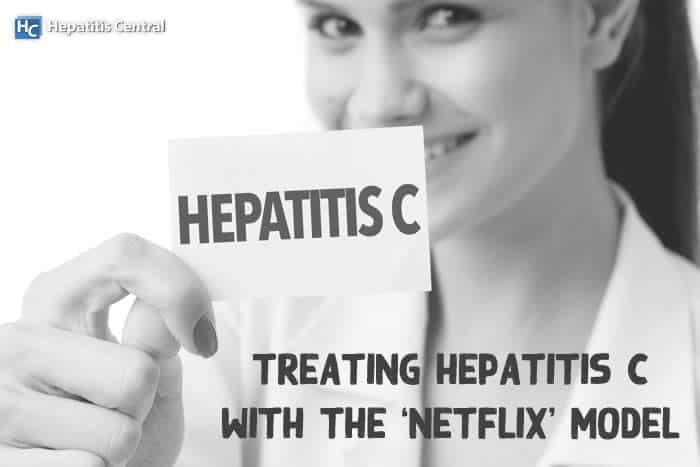Treating Hepatitis C with the ‘Netflix’ Model


There are around 71 million people worldwide that have chronic hepatitis C virus infection. One of the major causes of liver cancer and cirrhosis is the hepatitis C virus, which can lead to death. Getting the right treatment and medication can cure more than 95% of people with this virus, but the problem is access to diagnosis and treatment is low. (1) That is where this new ‘Netflix’ model can come into play.
What Is the ‘Netflix’ Model?
No this doesn’t require a Netflix subscription, but it has a similar approach as the streaming service. The ‘Netflix’ model is also referred to as a subscription-based reimbursement model. When it comes to medication, it involves paying a lump sum to manufacturers who then provide unlimited supplies of drugs to treat a specific population for a determined time period. This takes place of the more traditional negotiation that focuses on per-unit prices. (2)
What States Are Participating?
At this time, Louisiana and Washington state are the only two U.S. states taking advantage of this model. Louisiana was the first to jump on the ‘Netflix’ model train, paying around $58 million per year for 5 years (2019 to 2024) to receive unlimited amounts of Epclusa, a hepatitis C drug manufactured by Gilead Sciences, Inc. (3) Louisiana plans to treat around 31,000 to 39,000 Medicaid patients and prisoners who may have hepatitis C.
In the state of Washington, after federal rebates, they spent approximately $80.4 million in 2018 on hepatitis C drugs (known as direct-acting antivirals). This cost treated more than 3,300 patients. (3) With the new contract, they are looking at spending around the same amount of money each year but have the ability to treat almost double as many people.
Other states are rumored to be seeking information around this subscription model, but no specific identifications have been made. It wouldn’t be a shock to see New York join Washington state and Louisiana, with Governor Andrew Cuomo pledging to get rid of hepatitis C, which is believed to infect around 100,000 people in the state. (4)
Will This Model Be Beneficial?
Before Louisiana and Washington state took the chance on this new hepatitis C treatment, Australia did it. They began the ‘Netflix’ model in 2015, purchasing AU$1 billion to treat around 104,000 people with hepatitis C. By doing this, it’s believed they saved nearly AU$6.5 billion more than if they were to try and treat the same amount of people utilizing the traditional pricing method. (4)
Director of the Center for Evidence-Based Policy at Oregon Health & Science University, Pam Curtis tells USA Today (5) that the arrangements made in both Louisiana and Washington had an overall goal of reining in runaway drug prices, especially in state-run Medicaid programs. These kinds of programs don’t have the ability to shift costs like commercial markets, and instead would have to cut services. “States are already struggling,” says Curtis. “A larger and larger park of their budget is being eaten up by these new high-cost drugs.” Curtis also adds, “this is not a solution, but a step in the right direction.”
Conclusion
This new strategy to treating individuals with hepatitis C may be the solution needed to treat more individuals at a lower cost. Only time will tell to see if the outcomes in Louisiana and Washington state come with benefits. If results are positive, it’s possible this strategy may be able to expand to include other drugs.
- Hepatitis C. (n.d.). Retrieved December 7, 2020, from https://www.who.int/news-room/fact-sheets/detail/hepatitis-c
- Liu, H., Mulcahy, A., & Rose, A. (2020, May 21). Subscription Models for Prescription Drugs. Retrieved December 7, 2020, from https://www.rand.org/pubs/perspectives/PEA289-1.html
- Aleccia, J. (2019, October 31). Pharma Sells States on "Netflix Model" to Wipe Out Hep C. Retrieved December 7, 2020, from https://www.scientificamerican.com/article/pharma-sells-states-on-netflix-model-to-wipe-out-hep-c/
- A Netflix Model for Hepatitis C: One Price, Unlimited Meds. (n.d.). Retrieved December 7, 2020, from https://www.pewtrusts.org/en/research-and-analysis/blogs/stateline/2019/02/25/a-netflix-model-for-hepatitis-c-one-price-unlimited-meds
- Aleccia, J., Ostrov, B., & Blankinship, D. (2019, October 25). States make secret deals with drugmakers to fight hepatitis C – and taxpayers pick up the tab. Retrieved December 7, 2020, from https://www.usatoday.com/story/news/health/2019/10/25/abbvie-fights-hepatitis-c-states-make-secret-deals-drugmakers/4087441002/







